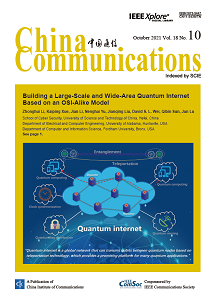利用带元标签的半监督学习进行射频指纹识别
IF 3.1
3区 计算机科学
Q2 TELECOMMUNICATIONS
引用次数: 0
摘要
射频指纹(RFF)是一种出色的轻量级身份验证方案,可支持物联网(IoT)系统中快速、可扩展的身份验证。通过利用硬件级特征,深度学习(DL)是 RFF 识别的重要推动力。然而,传统的监督学习方法需要大量的标注训练样本。因此,如何在实际应用中用少量标签建立高性能的监督学习模型仍是一个挑战。针对这一问题,我们在本文中提出了一种新颖的 RFF 半监督学习(RFFSSL)模型,它能在元标签较少的情况下获得更好的性能。具体来说,本文提出的 RFFSSL 模型由一个教师-学生网络构成,其中学生网络从教师预测的伪标签中学习。学生网络从教师预测的伪标签中学习,然后利用学生模型的输出来提高教师在标签数据中的性能。此外,我们还对准确性进行了综合评估。我们获得了约 50 GB 的真实长期演进(LTE)手机原始信号数据集,并用这些数据集来评估各种模型。实验结果表明,当训练样本等于 2700 个时,所提出的 RFFSSL 方案只需 10%的标记样本,就能在高噪声环境下实现高达 97% 的实验测试准确率。本文章由计算机程序翻译,如有差异,请以英文原文为准。
Radio frequency fingerprinting identification using semi-supervised learning with meta labels
Radio frequency fingerprinting (RFF) is a remarkable lightweight authentication scheme to support rapid and scalable identification in the internet of things (IoT) systems. Deep learning (DL) is a critical enabler of RFF identification by leveraging the hardware-level features. However, traditional supervised learning methods require huge labeled training samples. Therefore, how to establish a highperformance supervised learning model with few labels under practical application is still challenging. To address this issue, we in this paper propose a novel RFF semi-supervised learning (RFFSSL) model which can obtain a better performance with few meta labels. Specifically, the proposed RFFSSL model is constituted by a teacher-student network, in which the student network learns from the pseudo label predicted by the teacher. Then, the output of the student model will be exploited to improve the performance of teacher among the labeled data. Furthermore, a comprehensive evaluation on the accuracy is conducted. We derive about 50 GB real long-term evolution (LTE) mobile phone's raw signal datasets, which is used to evaluate various models. Experimental results demonstrate that the proposed RFFSSL scheme can achieve up to 97% experimental testing accuracy over a noisy environment only with 10% labeled samples when training samples equal to 2700.
求助全文
通过发布文献求助,成功后即可免费获取论文全文。
去求助
来源期刊

China Communications
工程技术-电信学
CiteScore
8.00
自引率
12.20%
发文量
2868
审稿时长
8.6 months
期刊介绍:
China Communications (ISSN 1673-5447) is an English-language monthly journal cosponsored by the China Institute of Communications (CIC) and IEEE Communications Society (IEEE ComSoc). It is aimed at readers in industry, universities, research and development organizations, and government agencies in the field of Information and Communications Technologies (ICTs) worldwide.
The journal's main objective is to promote academic exchange in the ICTs sector and publish high-quality papers to contribute to the global ICTs industry. It provides instant access to the latest articles and papers, presenting leading-edge research achievements, tutorial overviews, and descriptions of significant practical applications of technology.
China Communications has been indexed in SCIE (Science Citation Index-Expanded) since January 2007. Additionally, all articles have been available in the IEEE Xplore digital library since January 2013.
 求助内容:
求助内容: 应助结果提醒方式:
应助结果提醒方式:


